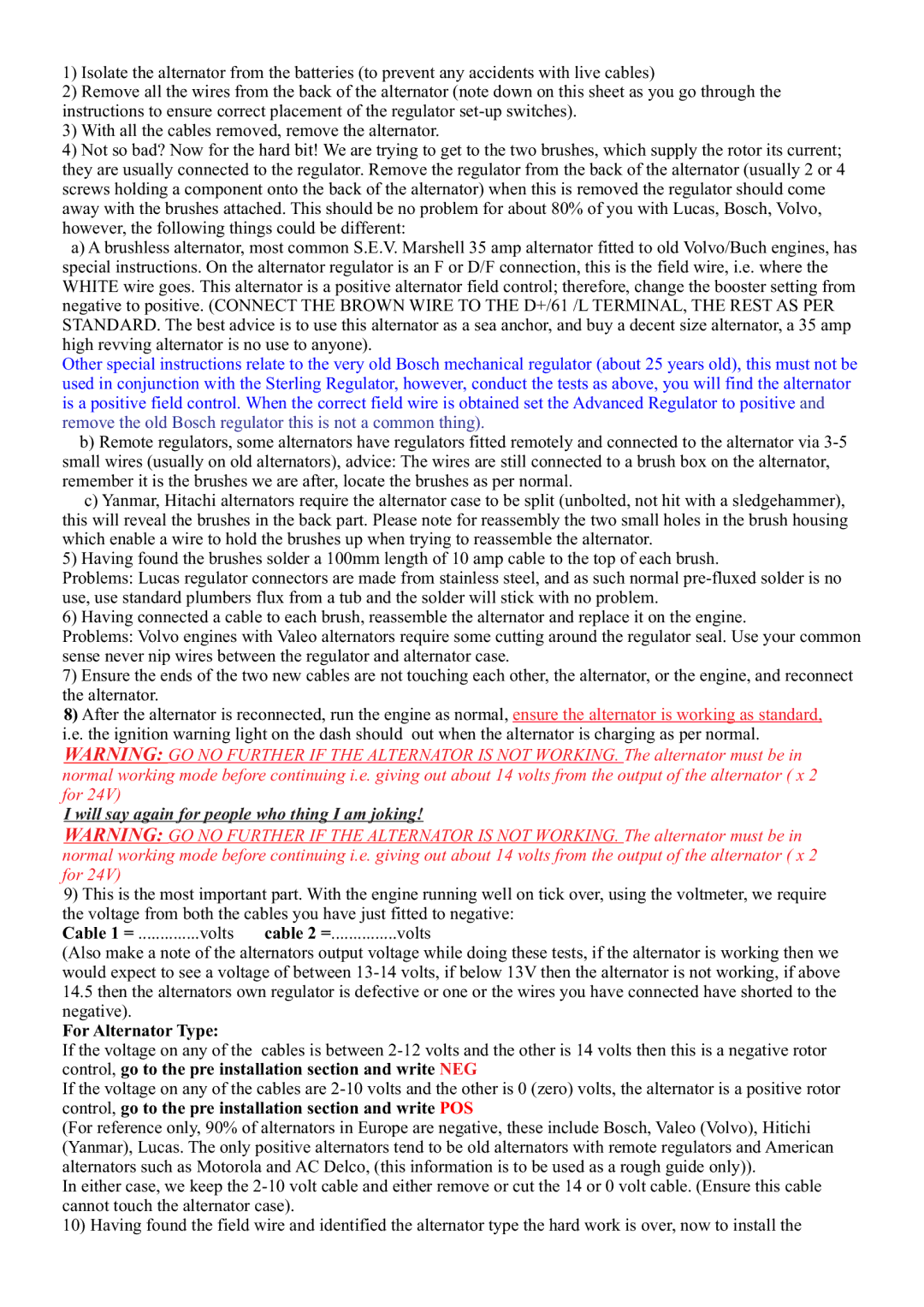
1)Isolate the alternator from the batteries (to prevent any accidents with live cables)
2)Remove all the wires from the back of the alternator (note down on this sheet as you go through the instructions to ensure correct placement of the regulator
3)With all the cables removed, remove the alternator.
4)Not so bad? Now for the hard bit! We are trying to get to the two brushes, which supply the rotor its current; they are usually connected to the regulator. Remove the regulator from the back of the alternator (usually 2 or 4 screws holding a component onto the back of the alternator) when this is removed the regulator should come away with the brushes attached. This should be no problem for about 80% of you with Lucas, Bosch, Volvo, however, the following things could be different:
a)A brushless alternator, most common S.E.V. Marshell 35 amp alternator fitted to old Volvo/Buch engines, has special instructions. On the alternator regulator is an F or D/F connection, this is the field wire, i.e. where the WHITE wire goes. This alternator is a positive alternator field control; therefore, change the booster setting from negative to positive. (CONNECT THE BROWN WIRE TO THE D+/61 /L TERMINAL, THE REST AS PER STANDARD. The best advice is to use this alternator as a sea anchor, and buy a decent size alternator, a 35 amp high revving alternator is no use to anyone).
Other special instructions relate to the very old Bosch mechanical regulator (about 25 years old), this must not be used in conjunction with the Sterling Regulator, however, conduct the tests as above, you will find the alternator is a positive field control. When the correct field wire is obtained set the Advanced Regulator to positive and remove the old Bosch regulator this is not a common thing).
b)Remote regulators, some alternators have regulators fitted remotely and connected to the alternator via
c)Yanmar, Hitachi alternators require the alternator case to be split (unbolted, not hit with a sledgehammer), this will reveal the brushes in the back part. Please note for reassembly the two small holes in the brush housing which enable a wire to hold the brushes up when trying to reassemble the alternator.
5)Having found the brushes solder a 100mm length of 10 amp cable to the top of each brush.
Problems: Lucas regulator connectors are made from stainless steel, and as such normal
6) Having connected a cable to each brush, reassemble the alternator and replace it on the engine.
Problems: Volvo engines with Valeo alternators require some cutting around the regulator seal. Use your common sense never nip wires between the regulator and alternator case.
7)Ensure the ends of the two new cables are not touching each other, the alternator, or the engine, and reconnect the alternator.
8)After the alternator is reconnected, run the engine as normal, ensure the alternator is working as standard,
i.e. the ignition warning light on the dash should out when the alternator is charging as per normal. WARNING: GO NO FURTHER IF THE ALTERNATOR IS NOT WORKING. The alternator must be in normal working mode before continuing i.e. giving out about 14 volts from the output of the alternator ( x 2 for 24V)
I will say again for people who thing I am joking!
WARNING: GO NO FURTHER IF THE ALTERNATOR IS NOT WORKING. The alternator must be in normal working mode before continuing i.e. giving out about 14 volts from the output of the alternator ( x 2 for 24V)
9)This is the most important part. With the engine running well on tick over, using the voltmeter, we require the voltage from both the cables you have just fitted to negative:
Cable 1 = ..............volts cable 2 =...............volts
(Also make a note of the alternators output voltage while doing these tests, if the alternator is working then we would expect to see a voltage of between
14.5then the alternators own regulator is defective or one or the wires you have connected have shorted to the negative).
For Alternator Type:
If the voltage on any of the cables is between
If the voltage on any of the cables are
(For reference only, 90% of alternators in Europe are negative, these include Bosch, Valeo (Volvo), Hitichi (Yanmar), Lucas. The only positive alternators tend to be old alternators with remote regulators and American alternators such as Motorola and AC Delco, (this information is to be used as a rough guide only)).
In either case, we keep the
10) Having found the field wire and identified the alternator type the hard work is over, now to install the
